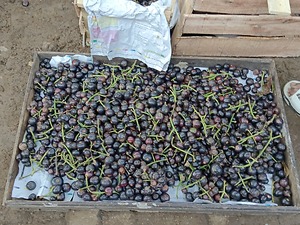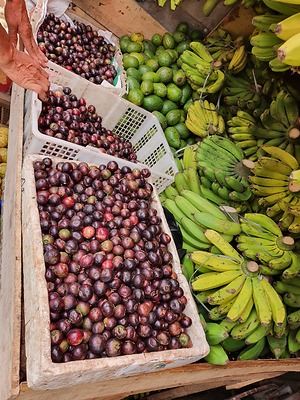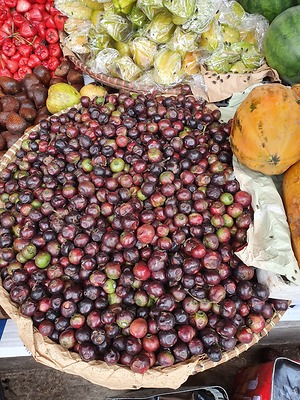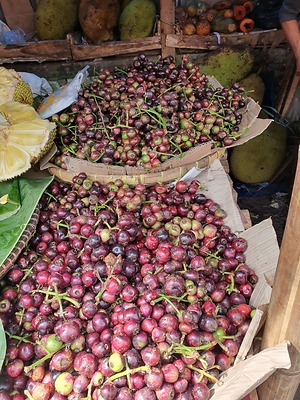


Gowok Fruit
Estimated Inventory, lb : 0
Description/Taste
Gowok fruits are small berries that grow in clusters on tree branches and trunks. They may resemble cranberries or blueberries, depending on their stage of maturity, and are small and round, measuring about 2 to 3 centimeters in diameter. These fruits mature from green to a deep maroon-red, eventually turning dark purple at their ripest point. Their smooth, shiny skin exhibits a mix of darker-colored patches and lighter areas. A small, bright green calyx at the base of the fruit matches the color of the branches from which they grow. Gowok fruits’ flesh has a whitish-pink hue and a creamy, succulent, and slightly jelly-like consistency. They have an astringent yet well-balanced sweet and sour flavor with a juicy texture.
Seasons/Availability
Gowok fruits are available year-round with a peak season in the spring and summer.
Current Facts
Gowok fruits are known botanically as Syzygium polycephalum and belong to the Myrtaceae family, which also includes guavas, rose apples, allspice, and cloves. They are also referred to as Kupa, Ruruhi, Dompyong, and Kaliasem. Gowok fruits are often confused with another tropical berry called lipotes, which are indigenous to a small area of the Philippines. Gowok fruits have a very similar appearance and grow in the same manner but are larger and have paler flesh. They grow on fruit trees in the Java and Kalimantan regions of Indonesia. These trees reach 8 to 20 meters high and develop dense, rounded canopies made of glossy dark green leaves and white flowers. Gowok fruit trees have ornamental value, as they are often cultivated in home gardens, as well as culinary values as the fruit is a popular local food.
Nutritional Value
Gowok fruits are a source of vitamin C, which plays a vital role in supporting the immune system, promoting healthy skin, and acting as an antioxidant. Gowok fruits also provide the body with dietary fiber, which aids in digestion, supports gut health, and helps regulate blood sugar levels. These fruits contain calcium, an important mineral for maintaining strong bones and teeth, as well as supporting muscle function and nerve signaling. The antioxidants in Gowok fruits may help fend off bacteria, inflammation, and tumors. They have been used historically to quench thirst and treat sore throats, bronchitis, asthma, dysentery, and ulcers.
Applications
Gowok fruits can be consumed raw, boiled, pickled, stewed, or preserved. At their ripest point, these fruits can be macerated, deseeded, and used to top granola and yogurt bowls, preserved in jams, or chopped up for baked goods like cakes and muffins. Firmer, less ripe fruits may be incorporated into a traditional Indonesian fruit salad with peanuts and chili peppers called rojak. Gowok fruits may be juiced or mixed into smoothies with fruits like pineapple, mangoes, watermelon, bananas, papaya, and dragon fruit. They can also be stewed with cinnamon, cloves, and sugar to make fruit compote to be served on top of rice. Gowok fruits may be pickled with vinegar and spices. They pair well with ingredients like shoots, cardamom, honey, limes, oranges, mint, basil, lemongrass, coconut, and tamarind. Gowok fruits will keep for about two days at room temperature and can be stored in the refrigerator for up to a week.
Ethnic/Cultural Info
Throughout Indonesia, the golden-brown colored wood of the Gowok tree is highly valued. Its fine-grained texture, combined with its hardness and durability, makes this wood a practical material for a variety of uses. One of its key attributes is resistance to fungi and termites, which is essential in tropical climates where such threats can damage wooden structures. Gowok trees are frequently used for building houses in the Southeast Asian forests where they are native. This wood is also utilized in crafting musical instruments, ships, and flooring.
Geography/History
Gowok fruits are native to the tropical regions of Southeast Asia, particularly the Indonesian islands of Java and Kalimantan in Borneo. They can also be found in Hawaii, the Philippines, Malaysia, Singapore, and the Indonesian archipelago. This variety thrives in tropical and subtropical climates. They can be found in the wild forests and hilly regions of Southeast Asia and are cultivated on a small commercial scale. These fruits were first cataloged by Dutch botanist Friedrich Anton Wilhelm Miguel during the mid-1800s. They became popular in the markets throughout Southeast Asia during the 1980s and 1990s. Gowok fruits are rare outside of Southeast Asia but can still be foraged from the wild and sourced from local markets in Java, Bali, and Kalimantan.











